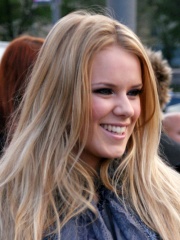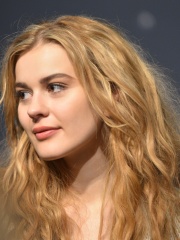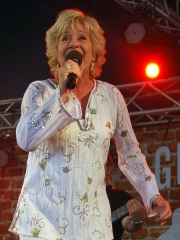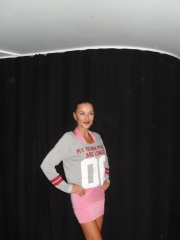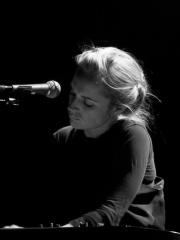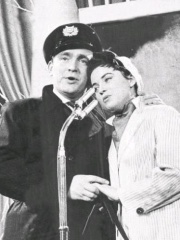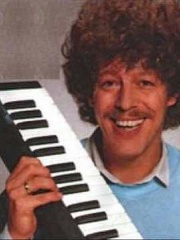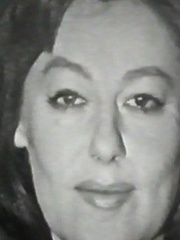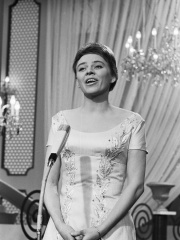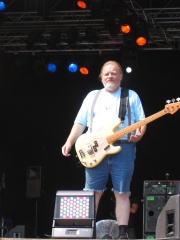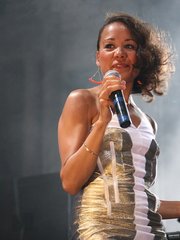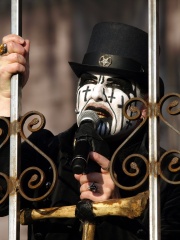
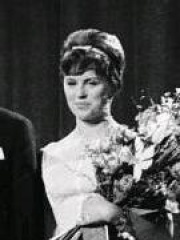
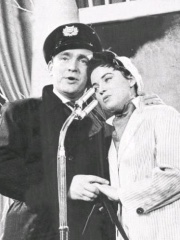
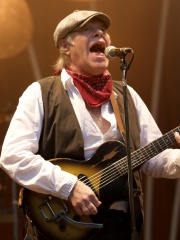
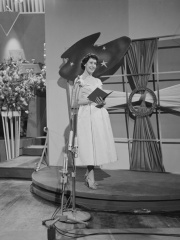
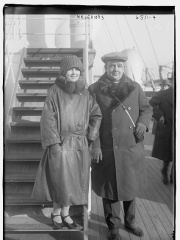


The Most Famous
SINGERS from Denmark
Top 10
The following people are considered by Pantheon to be the top 10 most legendary Danish Singers of all time. This list of famous Danish Singers is sorted by HPI (Historical Popularity Index), a metric that aggregates information on a biography's online popularity. Visit the rankings page to view the entire list of Danish Singers.

1. King Diamond (b. 1956)
With an HPI of 63.45, King Diamond is the most famous Danish Singer. His biography has been translated into 32 different languages on wikipedia.
Kim Bendix Petersen (born 14 June 1956), better known by his stage name King Diamond, is a Danish rock musician. As a vocalist, he is known for his powerful and wide-ranging countertenor singing voice, in particular his far-reaching falsetto screams. He is the lead vocalist and lyricist for both Mercyful Fate and the eponymous King Diamond. He also plays keyboards and guitars on studio recordings but uses live shows to focus solely on his vocal performance. Diamond is renowned for his dark lyrical content and his story concepts. He is also known for his distinctive shock stage persona (in particular his black and white facepaint). He has been an influence for other rock and metal artists, including Metallica, Slayer and Cradle of Filth.

2. Grethe Ingmann (1938 - 1990)
With an HPI of 61.67, Grethe Ingmann is the 2nd most famous Danish Singer. Her biography has been translated into 27 different languages.
Grethe Ingmann (born Clemmensen; 17 June 1938 – 18 August 1990) was a Danish singer. She started her career at 17, when she temporarily performed as a singer of the Malihini Hawaiians pop quartet. Soon after she sang with the Danish guitarist Jørn Grauengaard and his trio. In 1955 she met her future husband, guitarist Jørgen Ingmann. The couple married in 1956 and performed as the duo Grethe og Jørgen Ingmann. Together they won the Eurovision Song Contest 1963 representing Denmark with the jazz waltz "Dansevise" (Dancing tune) with music by Otto Francker and lyrics by Sejr Volmer-Sørensen. It was the first entry performed by a duo to win the Contest and also the first Scandinavian winner. In 1965 she entered the German Schlager Contest with the song "Sommerwind". She dropped out in the preliminaries, but the song's English version, written by Johnny Mercer in 1966 and sung by Frank Sinatra, became an international hit. Grethe and Jørgen Ingmann continued their musical career until they divorced in 1975. As a solo singer, Grethe participated in several Danish pre-selections for the Eurovision Song Contest, unsuccessfully. Notably, in 1979 she entered the Dansk Melodi Grand Prix with Bjarne Liller and the song "Alt er skønt", which tied for equal first at the end of the voting but placed second after a re-vote. The couple remarried in the 1980s. Grethe died of liver cancer on 18 August 1990, aged 52, becoming the first Eurovision winner to die.

3. Birthe Wilke (b. 1936)
With an HPI of 59.52, Birthe Wilke is the 3rd most famous Danish Singer. Her biography has been translated into 27 different languages.
Birthe Wilke (born 19 March 1936) is a Danish singer. She grew up in a musical family in Copenhagen's Vesterbro area.

4. Kim Larsen (1945 - 2018)
With an HPI of 59.02, Kim Larsen is the 4th most famous Danish Singer. His biography has been translated into 16 different languages.
Kim Mellius Flyvholm Larsen (23 October 1945 – 30 September 2018) was a Danish singer, songwriter, author, and guitarist. He began his musical career in 1968 after a brief period as an elementary school teacher and became known from 1969 as a member of the rock group Gasolin. During his time with Gasolin (which lasted until 1978), Larsen also released solo albums and records with his leisure band, which went by several names. After the disbandment of Gasolin, Larsen continued as a solo artist and band leader.
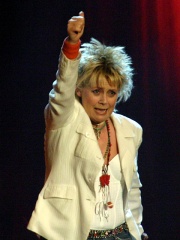
5. Gitte Hænning (b. 1946)
With an HPI of 58.65, Gitte Hænning is the 5th most famous Danish Singer. Her biography has been translated into 19 different languages.
Gitte Hænning (born 29 June 1946) is a Danish singer and film actress, who rose to fame as a child star in the 1950s. She was known primarily mononymously (without a surname) in Europe. She moved to Sweden in 1958. Her first hit in Swedish was "Tror du jag ljuger" from 1961. As a teenager, Gitte sang popular hits in German, English, Italian (4 songs: "Amo Johnny", "Parla", "La mela", and "Il ricordo", recorded on two singles), and Danish. She had five different number one hits in three countries: one in Denmark, two in Sweden, and two in Germany. Her first German number one song was "Ich will 'nen Cowboy als Mann". This recording sold 1.05 million copies by mid 1965, earning Gitte a gold disc. In 1962, she attempted to compete for Denmark in the Eurovision Song Contest with "Jeg Snakker med mig Selv", but was disqualified because the composer, Sejr Volmer-Sørensen, had whistled the song in the canteen of the Danish Broadcasting Corporation. In 1973, she competed for Germany in the Eurovision Song Contest with the song "Junger Tag". Her success continued after famous duets with Rex Gildo as 'Gitte & Rex' in a number of popular films. Gitte made an attempt to represent Luxembourg in the Eurovision Song Contest in 1978 with the song "Rien qu'une femme" but she lost out to the group Baccara. In the 1960s she also starred in several music and drama movies and on TV in Germany, Denmark, and Sweden. Gitte was among the most popular Schlager (hit music) singers of the post-war era, and continued to be popular in Germany and Denmark even as American music increasingly dominated the airwaves in the 1970s. She recorded a jazz album with The Kenny Clarke-Francy Boland Big Band in 1968. Through ensuing decades her singles still reached the German charts, but never with the same success she enjoyed in the 1960s. In the 1980s, she changed her image and performed more adult-oriented music. She won some awards as a singer/entertainer. Her chart entries ended in the mid-1980s, but she has continued to be a successful live performer to the present day. A number of compilation albums have been recently released in Germany, among them a biographical DVD. From 2004 to 2006 she starred with two other Scandinavian entertainers, Wenche Myhre and Siw Malmkvist, in a huge stage and tour success. The live CD recording of their show entered the German charts. In 2010, she presented a new CD, which also had a German chart entry. She had her first chart entry in 1960 in Sweden and her last in 2010 in Germany.

6. Raquel Rastenni (1915 - 1998)
With an HPI of 57.57, Raquel Rastenni is the 6th most famous Danish Singer. Her biography has been translated into 22 different languages.
Raquel Rastenni (21 August 1915 – 17 August 1998), born Anna Rachel Rastén, was a Danish-Russian singer. She was born in Copenhagen, and grew up in an apartment in the poor part of the city. Her Jewish parents immigrated to Denmark from Russia at the start of the 20th century. Her father was a tailor, and her mother was a seamstress. She started her career as a dancer in the Helsingør Revue in 1936. She debuted as a singer in 1938 by being broadcast on radio. She sang with various orchestras through the early 1940s and in 1940 formed her own swing trio. That same year her first record was released. She also toured during these years in Sweden. As a Jew, she fled Denmark in October 1943 along with her family, as the country had come under Nazi occupation. She spent the rest of the war years in Sweden where she continued having great success with her career, performing with orchestras and in cabarets and varieties. Her jazz singing style has been compared to that of Ella Fitzgerald. She returned to Denmark in 1945 and became Denmark's leading female ballad singer. Among her successes were Vovsen i vinduet ("(How Much Is) That Doggie in the Window?") in 1953 and Heksedansen ("The Witch Dance") in 1960. Her best-selling song was Hele ugen alene ("Seven lonely days") in 1953, which sold over 120,000 copies. She was the first artist in Denmark to earn a gold record. In addition to her Danish language recordings, she recorded also in Swedish, Yiddish and Hebrew. After qualifying in the Dansk Melodi Grand Prix to represent Denmark at the Eurovision Song Contest, she participated in Eurovision Song Contest 1958, where she sang Jeg rev et blad ud af min Dagbog] (I Tore A Page Out Of My Diary). She ranked number 8. She participated once more in the Danish Melodi Grand Prix, singing a duet with Grethe Sønck entitled Hjemme hos os ("At our home"). In the late 1980s, she retired from public life. She died in Skodsborg in the northern part of Sjælland at the age of 82.

7. Lauritz Melchior (1890 - 1973)
With an HPI of 57.35, Lauritz Melchior is the 7th most famous Danish Singer. His biography has been translated into 22 different languages.
Lauritz Melchior (20 March 1890 – 18 March 1973) was a Danish-American opera singer. He was the preeminent Wagnerian heldentenor of the 1920s through the 1940s and has come to be considered the quintessence of his voice type. Late in his career, Melchior appeared in movie musicals and on radio and television. He also made numerous recordings.

8. MØ (b. 1988)
With an HPI of 57.24, MØ is the 8th most famous Danish Singer. Her biography has been translated into 44 different languages.
Karen Marie Aagaard Ørsted Andersen (Danish pronunciation: [ˈkɑːɑn mɑˈʁiˀə ˈɔːˀkɒˀ ˈɶɐ̯steð ˈɑnɐsn̩]; born 13 August 1988), known professionally as MØ (pronounced [ˈmøˀ] ), is a Danish singer and songwriter. She signed a recording contract with Sony Music Entertainment in 2012 and released her debut extended play (EP), Bikini Daze (2013), and her debut studio album, No Mythologies to Follow (2014). In 2014, MØ collaborated with Australian rapper Iggy Azalea on the single "Beg for It", which peaked at number 27 on the US Billboard Hot 100, earning MØ her first entry on the chart. The following year, she co-wrote and provided vocals for the Major Lazer and DJ Snake collaboration "Lean On", which became an international success, charting at number one in several countries, number two in the United Kingdom, and number four in the United States. In 2016, MØ was featured on Snakehips's single "Don't Leave", and another Major Lazer single "Cold Water" with Canadian singer Justin Bieber; the latter debuted at number one on the UK Singles Chart and number two on the US Billboard Hot 100. MØ earned her first commercially successful solo single with 2016's "Final Song", which reached the top 10 in Denmark and Norway and the top 15 in Australia and the United Kingdom. She has since released the extended play When I Was Young (2017), and the studio albums Forever Neverland (2018), Motordrome (2022) and Plæygirl (2025).

9. Aneela Mirza (b. 1974)
With an HPI of 56.37, Aneela Mirza is the 9th most famous Danish Singer. Her biography has been translated into 18 different languages.
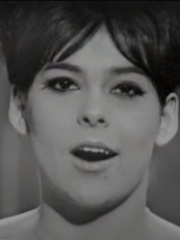
10. Ulla Pia (1945 - 2020)
With an HPI of 56.34, Ulla Pia is the 10th most famous Danish Singer. Her biography has been translated into 20 different languages.
Ulla Pia Nielsen (17 February 1945 – 22 August 2020), known simply as Ulla Pia, was a Danish singer, best known internationally for her participation in the 1966 Eurovision Song Contest. Ulla Pia was born in Copenhagen, where she started her career as a vocalist with bands and orchestras. In the mid-1960s she was singing with jazz musician Finn Ziegler, and it was suggested in 1966 that she enter a song in the Danish Eurovision selection, Dansk Melodi Grand Prix. She performed the song "Stop - mens legen er go'" ("Stop, While the Going's Good"), and to her surprise, emerged the clear winner. Ulla Pia stated in a recent interview that she had assumed that one of her better-known competitors (such as Dario Campeotto or Gustav Winckler) would win, and her victory came as a shock to her. Ulla Pia went forward to the eleventh Eurovision Song Contest, held on 5 March in Luxembourg City, where "Stop – mens legen er go'" could manage only 14th place of the 18 entries, despite an engaging performance in which Ulla Pia was joined on stage, unusually for the time, by two dancers. It would prove to be Denmark's last Eurovision appearance for over a decade, as broadcaster DR withdrew from the competition in 1967, and would not return until 1978. In the years following her Eurovision appearance, Ulla Pia went on to release several popular singles in Denmark, notably "Karina" and the topical "Flower Power Tøj". She toured regularly into the 1970s, but towards the end of the decade increasing family commitments, combined with a period of ill-health, caused her to retire from show business. Ulla Pia died on 22 August 2020, aged 75.
People
Pantheon has 45 people classified as Danish singers born between 1890 and 1998. Of these 45, 32 (71.11%) of them are still alive today. The most famous living Danish singers include King Diamond, Birthe Wilke, and Gitte Hænning. The most famous deceased Danish singers include Grethe Ingmann, Kim Larsen, and Raquel Rastenni. As of April 2024, 2 new Danish singers have been added to Pantheon including René Dif, and Camille Jones.
Living Danish Singers
Go to all RankingsKing Diamond
1956 - Present
HPI: 63.45
Birthe Wilke
1936 - Present
HPI: 59.52
Gitte Hænning
1946 - Present
HPI: 58.65
MØ
1988 - Present
HPI: 57.24
Aneela Mirza
1974 - Present
HPI: 56.37
Jóhanna Guðrún Jónsdóttir
1990 - Present
HPI: 54.90
Emmelie de Forest
1993 - Present
HPI: 53.83
Birthe Kjær
1948 - Present
HPI: 53.60
Whigfield
1970 - Present
HPI: 53.48
Agnes Obel
1980 - Present
HPI: 52.79
DQ
1973 - Present
HPI: 51.06
Bjørn Tidmand
1940 - Present
HPI: 50.79
Deceased Danish Singers
Go to all RankingsGrethe Ingmann
1938 - 1990
HPI: 61.67
Kim Larsen
1945 - 2018
HPI: 59.02
Raquel Rastenni
1915 - 1998
HPI: 57.57
Lauritz Melchior
1890 - 1973
HPI: 57.35
Ulla Pia
1945 - 2020
HPI: 56.34
Gustav Winckler
1925 - 1979
HPI: 56.31
Tommy Seebach
1949 - 2003
HPI: 56.04
Katy Bødtger
1932 - 2017
HPI: 55.93
Birgit Brüel
1927 - 1996
HPI: 55.22
Dario Campeotto
1939 - 2023
HPI: 54.01
Ellen Winther
1933 - 2011
HPI: 53.24
Flemming Jørgensen
1947 - 2011
HPI: 52.61
Newly Added Danish Singers (2025)
Go to all RankingsOverlapping Lives
Which Singers were alive at the same time? This visualization shows the lifespans of the 11 most globally memorable Singers since 1700.

